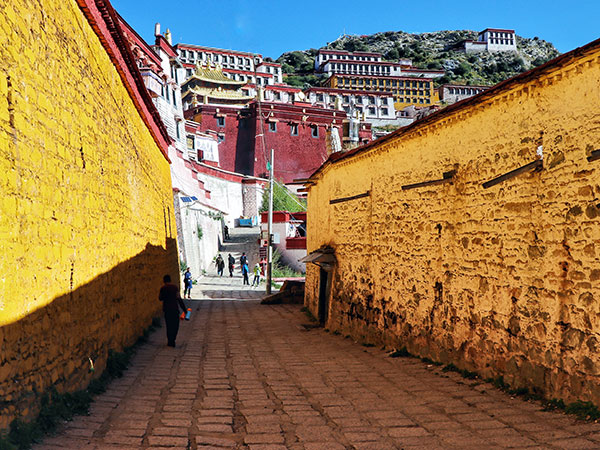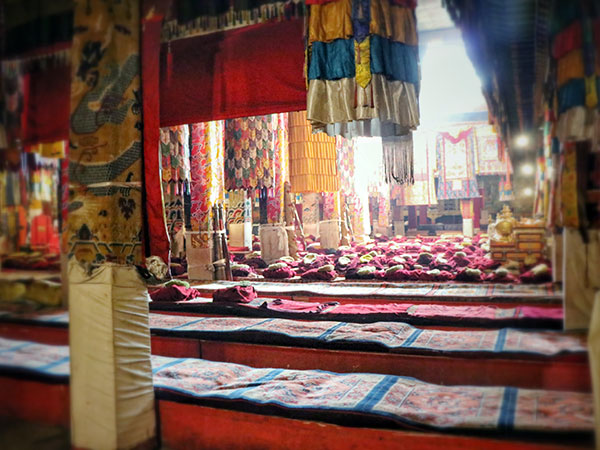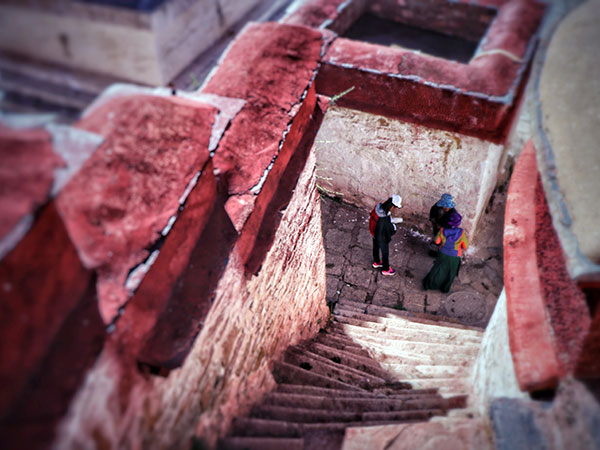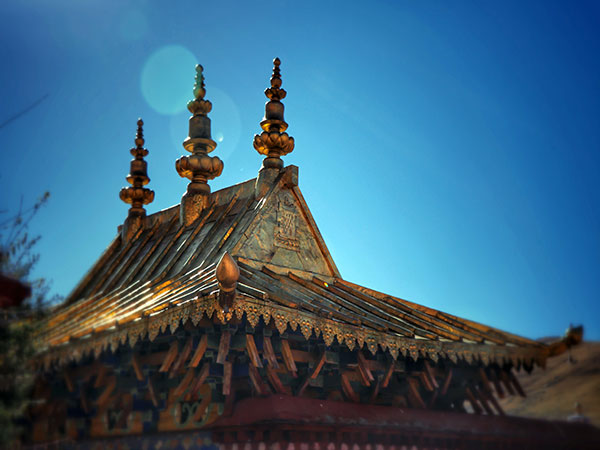Ganden Monastery (Chinese Name: 甘丹寺) is located on the southern bank of Lhasa River, 60 km from Lhasa City. It is one of the earliest and largest Buddhist monasteries in Tibet, and stands atop of the six famous temples of Gelugpa, a branch of Tibetan Buddhism. Every year, Buddha Painting Unfolding Festival is held in the monastery, attracting thousands of visitors and disciples.
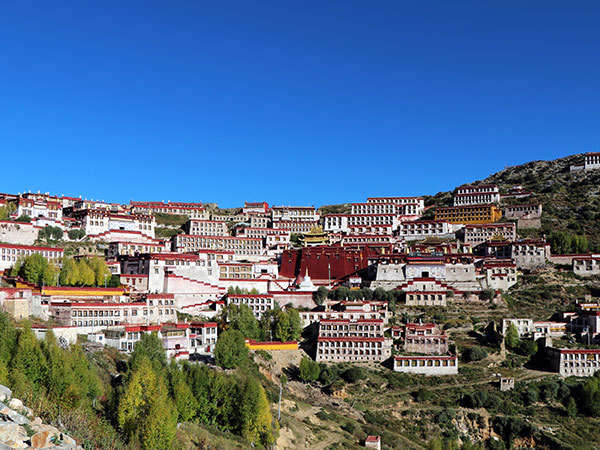
Ganden Monastery was completely destroyed during the rebellion of 1959. In 1966 it was severely shelled by Red Guard artillery and monks then had to dismantle the remains. Most of Tsongkhapa’s mummified body was burned but his skull and some ashes were saved from the fire by Bomi Rinpoche, the monk who had been forced to carry the body to the fire. Re-building has been continuing since the 1980s and the “red-painted lhakang in the centre is the reconstruction of Ganden’s sanctum sanctorum containing Tsongkapa’s reliquary chorten called the Tongwa Donden, ‘Meaningful to Behold.’
Since Ganden Monastery is the ancestral monastery of Gelugpa, the abbots of Ganden Monastery, the Ganden Tripas, are regarded as the abbots of Gelugpa as well. The Ganden Tripas are only outranked by the Dalai Lama and Panchen Lamas.
What to See
Ganden Monastery is the Chinese national key cultural relics protection unit. Ganden Monastery consists of more than 50 buildings, mainly composed of Tsochin hall, Tsongkhapa sleeping chamber, Yangbajian Sutra Hall, Tsongkhapa Stupa Hall, Jamze Dratsang, Xaze Dratsang and 23 Khangtsengs, and 20 Myicuns. Tsochin hall (meaning the main assembly hall, that is the great buddha’s hall), founded in 1409, 43.8 meters wide, 44.7 meters deep, with 108 large columns, can accommodate 3300 monks to chant at the same time.
Ganden Monastery has 23 khangtsens, each has a small scripture hall, most of the buildings are two-storey with an area of 400 square meters or more, the general capacity of 200 monks to chant buddhist scripture at the same time. Under the khangtsen is myicun, which is the most basic management institution of temple. Ganden Monastery has a total of 20 myicuns. In addition, there is nine-storey high palace constructed by the main benefactor of the Ganden monastery Dagze Tsongben.
【The Gelug Sect Monastery (格鲁派寺院)】
Ganden Monastery was built in seventh years of Yongle period in Ming dynasty (AD 1409), which was established by the founder of the gelug sect Tsongkhapa with the support of local government leaders. Tsongkhapa built Ganden’s main temple, with large statues and three-dimensional mandalas. He often stayed at Ganden, and died there in 1419. Before dying Tsongkhapa gave his robe and staff to the first Ganden Tripa, Gyeltsabjey (AD 1364-1432), who was succeeded by Kaydrubjey, and he was called tripa, from then on was produced Ganden Tripa inheritance system. Within the Ganden monastery there is divided into two dratsangs (means colleges), Jamze (or Jangtse) dratsang and Xaze (or Shartse) dratsang, laid the foundation of the gelug sect. Originally known as “Ganden Monastery Sect”, referred to as “Ganden Sect”, later evolved into “the gelug sect”. In addition, there are people called “new Kadam sect”. The establishment of the Ganden Monastery marked the Tsongkhapa and its followers appeared in Tibet Buddhist circle with an attitude of independently of new denomination.
【Tri Thok Khang (赤妥康)】
Tsongkhapa bedchamber is namely “Tri Thok Khang”, is the place that served Tsongkhapa and successive Ganden tripas’ daily life and to practiced initiate. It was built in 1409 and extended in1720 by Sonam Dorjee, and during the seventh dalai period added gold-capped roofs. Inside the hall are enshrined statues of the Sitatapatra and Manjushri Bodhisattva, and other gilding statues. Inside also there are the Buddha mandalas for Shamanism to practice, namely Guhyasamāja tantra, Blissful Vajra, Yamantaka, Vajrapani of four mandalas, also known as nirvana. And there were Tsongkhapa used cassock, cushion, seal, etc. Because inside there kept Tsongkhapa and successive Ganden tripas used clothing, so here also known as “Clothing-Preserving Hall”.
【Tsochin Hall (措钦大殿)】
Tsochin Hall (also called Lagyi hall), in its left is Yangbajian Sutra Hall of four-storey, with 72 columns, covers an area of 800 square meters. It was built in 1409, and finished in 1416, in 1610 the fourth panchen lama added gold-capped roofs. Inside the back wall there is a piece of giant stone, according to legend it came from a place called Yangbajian in India, therefore the hall called “Yangbajian”, as the main Buddhist Guardian Hall of Ganden Monastery. Inside the Buddha Halls are statues of the Maitreya Buddha and the master Tsong Khapa, the initiator of Gelugpa. The mandalas are made in gilding copper, of which the gods are silver casting, fine with molding, dressed up glittering, and with beautiful murals surrounded, hanging decorated flags, luxurious columns, which looks like the dragon king’s palace.
【Yangbajian Sutra Hall (羊八犍经院)】
On the top of Yangbajian Sutra Hall is for Tsongkhapa Holy Stupa Hall that is “Serdung”, three-storey, covers an area of 360 square meters. On October 25, 1419, Tsongkhapa passed away in Tri Thok Khang. In 1420, his disciple Gyaltsab Je built this stupa and silver and gold encrusted tomb to entomb preserved body of Tsongkhapa. Origianlly, the stupa was encrusted with silverskin, afterwards, the tenth Ganden tripa Gendom Pyongtso got a year tax of Qinghai region from Samdhong Rinpoché and changed it into gold, he covered the stupa with pure gold then and decorated with precious jewels, made it a very magnificent golden pagoda. In 1921, the thirteenth Dalai Lama Thubten Gyatso repaired it, and its appearance became more magnificent. From then on, each time a tripa died, a silver pagoda would be built in their honor. In the time leading up to the liberation of Tibet, 95 pagodas were built.
【Lima Temple (里玛神殿)】
Lima Temple in the Ganden Monastery enshrined the statues of Sakyamuni consecrated by Dharma Drakpa Gyaltsen and one hundred of various Tsongkhapa statues practiced initiate in Yamataka mandala. In addition, the temple enshrined carved ivory Buddha made by Sakyamuni reportedly, Buddha statue made by Nagarjuna used the Ganges river sediment, Tsongkhapa statue and so on.
【Two Dratsangs (两大扎仓)】
Ganden Monastery has two big dratsangs, Shargtse Dratsang and Jangtse Dratsang. Jangtse Dratsang (meaning “north top monastery”) is the second Ganden tripa’s bedchamber, and also his daily life retreat. It was built by Tsongkhapa self-passing on disciple. The scripture hall has 84 columns, covers an area of 930 square meters, can accommodate 1500 monks to chant sutras at the same time. The theories of teaching of these two dratsangs are works of Tsongkhapa and his disciples. Both dratsangs combine the study of sutra and tantra. Study methods include memorization, logic and debate. The colleges grant degrees for different levels of achievement, evaluated by examination and formal public debate. And the Khenpo of these two dratsangs called Quji, responsible for administration and the educational administration in Ganden monastery. And then Jangtse and Shartse two dratsangs khenpo was adopted as heir of the gelug sect in turn. According to historical records, since Zongkapa’s time, 97 generations of Ganden tripas have ruled the Ganden monastery.
History Development
Ganden Monastery built in seventh year of Ming dynasty Yongle period (AD 1409), located in Dagze county, 40 kilometers to the east of Lhasa, and it is on the south bank of Lhasa River, the peak of an altitude of 3800 meters of Wangbur Mountain and Gongba Mountain. Tsongkhapa, founder of the shamanism in 15th century, carried out the religious reform, Ganden monastery is the first gelug sect monastery he personally built.
Tsongkhapa died in 1419 in Ganden Monastery, and his preserved body was entombed at Ganden by his disciples in a silver and gold encrusted tomb. The cave Tsongkhapa cultivated himself is located on the commanding heights of the east of monastery, it is also a famous monuments. Below it is the bedchamber for the Tsongkhapa, and inside there are Tsongkhapa scriptures relics, rochet, seals, etc.
Qing dynasty Yongzheng period eleventh years (1733) the Qing sejong named Ganden Monstery as “Yongtai temple”. The highest abbot of Ganden Monastery called Ganden Tripa. Because the Ganden Monastery is the Gelug sect of ancestral monastery, so Ganden tripa is also presided over the whole of the Gelug sect, whose status is ranked after the dalai lama and panchen lama.
Tsongkhapa in the early 15th century carried out “Reformation”, got rid of some of the old Tibetan Buddhism age-old malpractice, and based on the Kadam sect doctrine which originated by Attisha, created by Dromtönpa, so new Gelug sect is also called as new Kadam sect. And because this sect monks wear with yellow mitre, so it is also called Shanmanism. In early 1409, Tsongkhapa has successfully established Monlam in Jokhang temple in Lhasa, marked he was held in high regard in the aspect of religious teachings by monks and laymen in Tibet. Eventually Shanmanism has developed to become the largest Tibetan Buddhism sect.
Before the democratic reform of Tibet, Ganden Monastery personnel allocation are 3300, and the most up to 5000 to 6000. Monks democratic management committee was established in 1959, from teaching, learning, production, living in the monastery, all democratically managed by monks. The state council evaluated it as a national key cultural relics protection unit in 1962. During “Cultural Revolution”, the temple was destroyed. After 1980 the country allocated funds to the temple and has carried on the thorough maintenance: rebuilt the Tsongkhapa stupa, redrew the Yangbajian hall murals, reprinted the Kangyur and Tibetan Bstan-h!gyur tripitaka, maintained more than twenty monks dormitories. Inside the monastery there are one hundred and eighty-five monks, carrying on the normal buddhist activities.
Travel Guide of Ganden Monastery
【How to get to Ganden Monastery】Every day at 7:00 in the morning around Jokhang Temple in Lhasa, there are buses heading going to Ganden Monastery, 2 hours’ driving; or you can take the bus in Lubu parking lot to Ganden Monastery; the car rental for round trip to Ganden costs around 250 RMB.
【Best time to travel Ganden Monastery】Summer is the peak season for photography, during Sholton Festival shows Buddha paintings in Ganden Monastery. The Buddha is not huge as Drepung, but very beautiful.
Every October 25 in Tibetan Calendar is the deathday of Tsongkhapa, during that day, in the temple there will show 26 meters long, 10 meters wide of the giant Buddha, the temple at night will light to worship, very grand ceremony. It is the most important traditional festival of Ganden Monastery, called “Ganden Angque”, means Lamp Festival, it is more grand even than the Sholton Festival.

